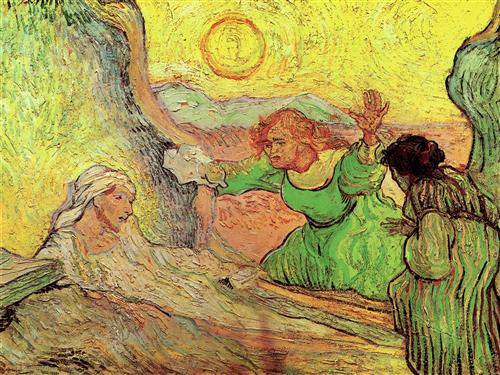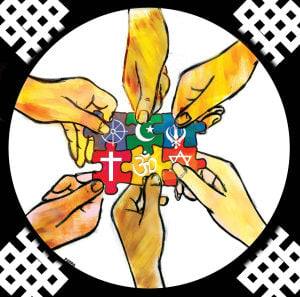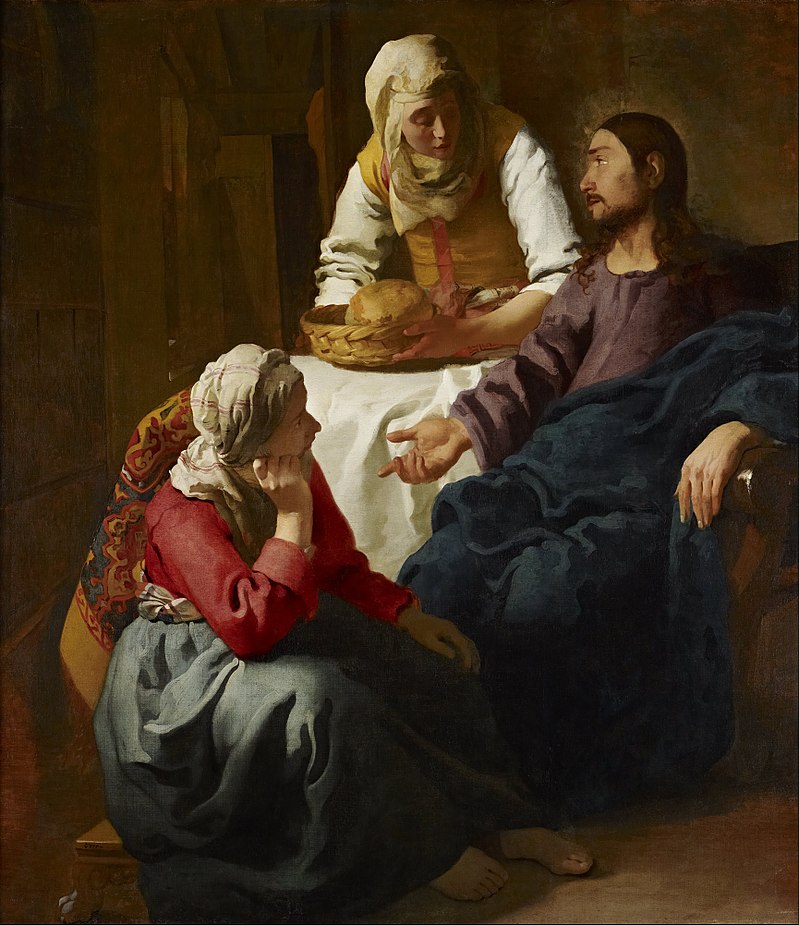 “Christ in the House of Martha and Mary,” by Velázquez (1618)
“Christ in the House of Martha and Mary,” by Velázquez (1618)
* * * *
The next major feast day – after Mary Magdalene, “Apostle to the Apostles” – is for Mary and Martha of Bethany, celebrated on July 29. (Not counting July 25. For that feast day see “On St. James the Greater,” from 2014. The Bible readings are at St James, Apostle.)
The July 29 Gospel for Mary and Martha of Bethany is Luke 10:38-42:
Now as Jesus and his disciples went on their way, he entered a certain village, where a woman named Martha welcomed him into her home. She had a sister named Mary, who sat at the Lord’s feet and listened to what he was saying. But Martha was distracted by her many tasks; so she came to him and asked, “Lord, do you not care that my sister has left me to do all the work by myself? Tell her then to help me.” But the Lord answered her, “Martha, Martha, you are worried and distracted by many things; there is need of only one thing. Mary has chosen the better part, which will not be taken away from her.”
As Wikipedia noted, this episode is usually interpreted as meaning “spiritual values [are] more important than material business, such as preparation of food.” The article said this mirrored what Jesus said in Luke 4:4 (as part of His Temptation by Satan): “It is written: ‘Man shall not live on bread alone.'” (Citing Deuteronomy 8:3.) Not to mention John 6:63, “The Spirit alone gives eternal life. Human effort accomplishes nothing.” (Referring to eternal life.)
 Also, these two sisters had a brother, Lazarus. See Martha – Wikipedia. He’s the man that Jesus raised from the dead. (As shown at right – by van Gogh – but not to be confused with the “beggar Lazarus.” See Luke 16:19–31 and parable of the rich man and Lazarus.)
Also, these two sisters had a brother, Lazarus. See Martha – Wikipedia. He’s the man that Jesus raised from the dead. (As shown at right – by van Gogh – but not to be confused with the “beggar Lazarus.” See Luke 16:19–31 and parable of the rich man and Lazarus.)
So anyway, here’s what Women in the Bible said of these two-sisters-and-a-brother. First of all: “None of the three appeared to be married.” That alone was highly unusual in Jewish society of the time, “where people were usually married before the age of 20.” Thus the consensus is that all three siblings were “quite young, perhaps still in their teens.”
Another interpretation is that the three were “on the edge of society,” or otherwise worthy of being shunned, or seen as “unclean.” Yet despite that possibility, “they seem to have been young, comparatively well-off, independent, and intelligent.” Finally, the article said this:
[In this episode] Jesus was ignoring the traditional role of women, and encouraging Mary to think and learn. He upheld her right to listen, think about ideas, and to develop her mind. She should not be limited to the tasks that society laid down for her, but be allowed access to ideas, as Jewish men were.
 See also The Martha Syndrome and the Mary Solution – Religious tolerance (as illustrated at left) which added: “Our unbelief can block God’s miracles in our lives.” (And that’s a point worth remembering.) The article cited John 11:40, in the account of John’s Gospel, of the raising of Lazarus:
See also The Martha Syndrome and the Mary Solution – Religious tolerance (as illustrated at left) which added: “Our unbelief can block God’s miracles in our lives.” (And that’s a point worth remembering.) The article cited John 11:40, in the account of John’s Gospel, of the raising of Lazarus:
Jesus said, “Remove the stone.” Martha, the sister of the deceased, said to Him, “Lord, by this time there will be a stench, for he has been dead four days.” Jesus said to her, “Did I not say to you that if you believe, you will see the glory of God?“
See also Matthew 17:20 and Mark 9:23, not to mention Exodus 16:7, “you will see the glory of the LORD, because he has heard your grumbling against Him.” (The emphasized portion adds an interesting “plot twist” to the concept of communicating with God…)
But getting back to the topic at hand, see Mary and Martha of Bethany 29 July:
Christian writers have seen Mary as representing Contemplation (prayer and devotion), and Martha as representing Action (good works, helping others)… Contemplation has fewer results, but one of those results is Faith, without which it is impossible to please God.” (Hebrews 11:6) Yet, there is a sense in which Action comes first – “If a man love not his brother, whom he hath seen, how shall he love God, whom he hath not seen?” (1 John 4:20)
Which brings up the question: Which of these examples should we we follow? Should we follow Mary’s path, and let our earthly concerns tend to themselves? Or should we follow Martha’s way, a live a life of service to others? Maybe the best answer is both…
See for example, Mary and Martha … who were they? The site argued that far from being bickering sisters, these two were a team, each complementing the other:

Mary and Martha need not tame dragons [as shown at right] to engage the modern reader … they have much to offer beyond their imagined rivalry. In Vermeer’s painting [shown below], Jesus points toward Mary, not as a rebuke to Martha but as a gentle reminder that leadership demands both the ability to listen and the ability to act. Finally, Mary and Martha are not at odds but form two parts of a whole. (E.A.)
Which is another way of saying that the debate over which is the better path – faith or works – has been going for most if not all the 2,000 years since the Church was born. See for example, Faith and Works – Reconciling the Two Doctrines:
[B]elievers are … declared righteous before God solely by faith… Works, on the other hand, are the evidence of genuine salvation. They are the “proof in the pudding,” so to speak. Good works demonstrate the truth of one’s faith.
So on this 29th day of July, 2015, Mary and Martha remind us that we need not “be at odds with each other” over religion. Instead we need to work on becoming two – or more – “parts of the whole.” (And – like many other efforts while we’re on this earthly pilgrimage – it may be easier to do it on your own, but it is definitely not as much fun…)

Christ in the House of Martha and Mary, (1655)
* * * *
The upper image is courtesy of Jesus at the home of Martha and Mary. The caption: “‘Christ in the House of Martha and Mary,’ Diego Velázquez, 1618.” There’s more input on the painting below.
The “bright yellow” image is courtesy of The Raising of Lazarus after Rembrandt – Vincent van Gogh.
The “tolerance puzzle” image is courtesy of thesouthern.com/religious-tolerance.
Re: “if you believe.” See also the Gospel for July 25, 2015: Mark 6:1-13, on Jesus confronting a lack of faith in His home town: “He could do no deed of power there, except that he laid his hands on a few sick people and cured them. And he was amazed at their unbelief.” (See Mark 6:6.)
Re: Mary representing contemplation. The quote included this:
They [Christian writers] see the same symbolism also in Leah and Rachel, the daughters of Laban (Genesis 29 and 35). Leah was dim of sight, but had many children. Rachel had few children, but one of them saved the whole family from destruction. Leah represents Action, which is near-sighted and cannot penetrate very far into the mysteries of God, but produces many worth-while results.
Re: Faith and works. See also The Controversy Over Faith And Works Continues.
The “St. George and dragon” image is courtesy of Collections of the National Gallery of Art, and/or Saint George and the Dragon (Raphael).
The lower image is courtesy of Christ in the House of Martha and Mary (Vermeer) – Wikipedia.
* * * *
Here’s that “more input,” from the Velasquez painting link as noted above:
The plight of Martha clearly relates to that of the maid in the foreground. She has just prepared a large amount of food and, from the redness of her creased puffy cheeks, we can see that she is also upset. To comfort her (or perhaps even to rebuke her), the elderly woman indicates the scene in the background reminding her that she can not expect to gain fulfillment from work alone. The maid, who cannot bring herself to look directly at the biblical scene and instead looks out of the painting towards us, meditates on the implications of the story…
This is the most likely interpretation[, but some] have argued over the identities of the characters, suggesting that the maid in the foreground is actually Martha herself and the lady standing in the background is just an incidental character…. On the one hand, we may be looking at a mirror or through a hatch at the biblical scene. If so, it would imply that the whole painting, foreground and background, is set in Christ’s time and would perhaps lend weight to the argument that the maid in the foreground is Martha. On the other hand, the biblical scene may just be a painting which is hung in the maid’s kitchen.
Finally, the article noted that when he did this painting, “Velázquez was experimenting with the potential of the bodegones, a form of genre painting set in taverns (the meaning of bodegon) or kitchens … to relate scenes of contemporary Spain to themes and stories from the Bible.” And that whatever the interpretation, “we can appreciate this as an early example of Velázquez’s interest in layered composition, a form also known as ‘paintings within the painting.'” See also A Painting Within a Painting: Hidden Messages in Dutch Art.